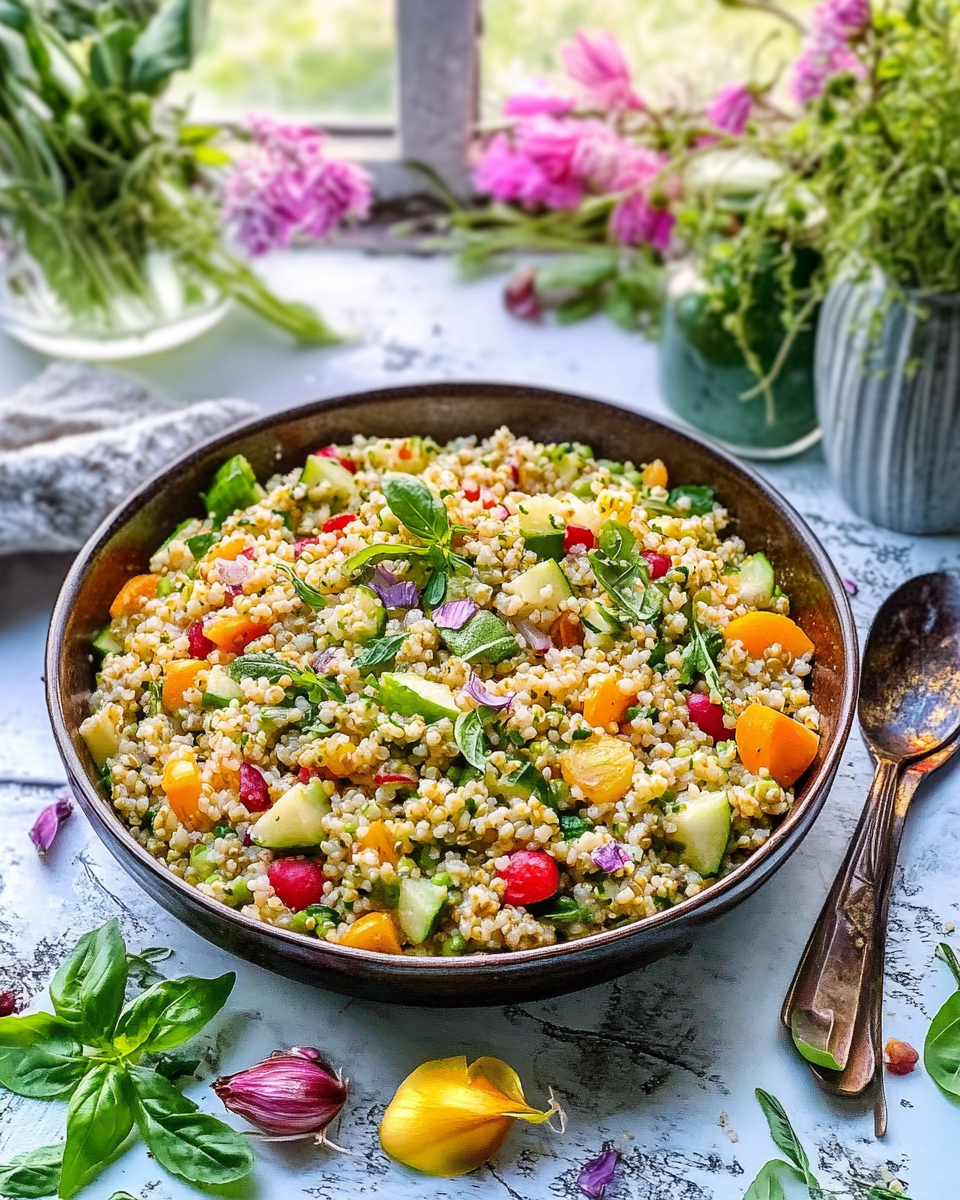A vibrant and fresh quinoa salad filled with spring vegetables. This dish is perfect for a light lunch or as a side for any meal. It combines the nutty flavor of quinoa with crisp vegetables like peas, asparagus, and radishes, making it a refreshing choice for warm weather.
FULL RECIPE
Ingredients
- 1 cup quinoa
- 2 cups water or vegetable broth
- 1 cup snap peas, trimmed and chopped
- 1 cup asparagus, chopped
- 1/2 cup radishes, thinly sliced
- 1/4 cup red onion, finely chopped
- 1/4 cup fresh parsley, chopped
- 1/4 cup feta cheese, crumbled (optional)
- 1 tablespoon olive oil
- 2 tablespoons lemon juice
- Salt and pepper to taste
Directions
- Rinse the quinoa under cold water. In a medium saucepan, combine quinoa and water (or vegetable broth). Bring to a boil, then reduce the heat and cover. Simmer for about 15 minutes, or until the quinoa is cooked and the water is absorbed.
- While the quinoa cooks, blanch the peas and asparagus. Bring a small pot of water to a boil. Add the asparagus and peas, cooking for 2-3 minutes. Drain and immediately transfer to a bowl of ice water to stop the cooking process. Drain again once cooled.
- In a large bowl, combine the cooked quinoa, blanched peas, asparagus, radishes, onion, and parsley. Toss to combine.
- Drizzle with olive oil and lemon juice, then season with salt and pepper to taste. Gently toss again.
- Top with crumbled feta cheese, if using. Serve chilled or at room temperature.
Nutritional Information
- Calories: 250 per serving
- Protein: 8g
- Carbohydrates: 35g
- Fiber: 5g
- Fat: 10g
- Sodium: 200mg
- Vitamin C: 25% of the daily value
- Calcium: 4% of the daily value
Health Benefits of Quinoa
Quinoa is often referred to as a “superfood” due to its impressive nutritional profile. It’s naturally gluten-free, high in protein, and contains all nine essential amino acids, making it a complete protein source. This makes quinoa an excellent choice for vegetarians and vegans looking to meet their protein needs. Additionally, quinoa is rich in fiber, which supports healthy digestion, helps regulate blood sugar levels, and can contribute to a feeling of fullness, potentially aiding in weight management. Its abundance of antioxidants also helps combat oxidative stress and inflammation in the body, promoting overall health.
Why Spring Vegetables?
Spring vegetables like peas, asparagus, and radishes are not only visually appealing but also pack a punch in terms of nutrients. These vegetables are fresh and light, offering a burst of vitamins and minerals. Asparagus is particularly high in vitamins A, C, E, and K, as well as folate, while radishes are rich in antioxidants and help promote detoxification. The combination of these seasonal vegetables in your salad provides a refreshing, nutrient-dense base that enhances both the taste and nutritional value of the dish.
Versatility of Quinoa Salad
One of the best features of quinoa salad is its versatility. You can easily swap out the vegetables in this recipe based on what you have in your fridge or what’s in season. For example, if you don’t have asparagus, you could replace it with zucchini or green beans. The dressing can also be modified to suit your tastes; for instance, you could add some Dijon mustard for a tangy kick or use balsamic vinegar instead of lemon juice for a richer flavor.
Perfect for Meal Prep
This quinoa salad is an excellent choice for meal prep. It stores well in the refrigerator for up to three days, making it a great option for preparing meals in advance. The salad can be enjoyed cold, at room temperature, or even slightly warmed up, making it a flexible dish for any time of day. The quinoa and vegetables hold up well over time, and the flavors continue to develop, making each serving even better than the last.
Balancing Flavors with the Right Dressing
The dressing in this recipe is simple yet effective in bringing all the ingredients together. The olive oil provides healthy fats, while the lemon juice adds a bright, refreshing tang. The combination of olive oil and lemon balances the earthy taste of quinoa with the crispness of the vegetables. You can experiment with adding different herbs, spices, or even a bit of honey for sweetness, depending on your preferences.
Adding Protein to Your Salad
While quinoa is already a good source of plant-based protein, adding extra protein to the salad can turn it into a more substantial meal. You can add grilled chicken, roasted chickpeas, or even a hard-boiled egg for extra protein. If you’re looking for a vegetarian option, roasted tofu or a dollop of hummus also work wonderfully, providing both texture and flavor.
Seasonal Eating and Sustainability
Eating with the seasons not only enhances the flavor and nutritional content of your food but also supports local farmers and reduces the environmental impact of transporting out-of-season produce. By choosing spring vegetables like peas, radishes, and asparagus, you are enjoying fresh, seasonal ingredients that are grown closer to home, helping to reduce the carbon footprint associated with your meals.
How to Make Your Salad More Colorful
Adding a variety of colorful vegetables to your quinoa salad not only makes it visually appealing but also increases its nutrient content. The different colors of vegetables typically indicate different types of antioxidants and vitamins. For example, red peppers add vitamin C, while yellow corn provides a good source of fiber. Including a range of colors in your salad ensures you’re getting a variety of nutrients that support overall health.
Improving Digestion with Quinoa and Fiber
Quinoa’s fiber content is a key player in promoting digestive health. Fiber helps regulate bowel movements, preventing constipation and maintaining a healthy gut. It also supports the growth of beneficial gut bacteria, which is crucial for overall digestive health. Additionally, the fiber in quinoa slows down the digestion of carbohydrates, leading to more stable blood sugar levels and longer-lasting energy.
The Role of Healthy Fats in the Salad
Incorporating healthy fats into your meals is important for maintaining heart health and supporting cell function. The olive oil in this quinoa salad provides a good dose of monounsaturated fats, which have been shown to reduce the risk of heart disease. If you’re looking for additional healthy fats, you could sprinkle some avocado or nuts like almonds or walnuts on top of your salad for added crunch and richness.
Creating a Balanced Meal
To make this quinoa salad a balanced meal, it’s important to include a good mix of carbohydrates, protein, healthy fats, and fiber. Quinoa provides complex carbohydrates and protein, while the vegetables add fiber and essential vitamins. The olive oil contributes healthy fats, ensuring that each serving is satisfying and nourishing. For an extra boost, you can add some seeds, nuts, or even a scoop of Greek yogurt for additional protein and creaminess.
Catering to Dietary Restrictions
This quinoa salad is naturally gluten-free and can easily be adapted to suit a variety of dietary restrictions. If you follow a dairy-free diet, you can simply leave out the feta cheese or substitute it with a dairy-free cheese alternative. Those on a vegan diet can add extra vegetables or legumes like chickpeas for additional protein. The recipe is also suitable for those following a low-carb or paleo diet when adjusted for ingredients like the dressing.
The Impact of Fresh Herbs
Fresh herbs like parsley add a bright, aromatic flavor to the salad. Not only do they elevate the taste, but they also contribute a wealth of nutrients. Parsley is known for its antioxidant properties and its ability to support kidney health. It’s also a good source of vitamin C, which is essential for immune function. Fresh herbs are an easy way to add flavor without extra calories, sugar, or salt.
How to Make the Salad Gluten-Free
If you’re catering to someone with gluten sensitivity or celiac disease, this quinoa salad is a perfect option since quinoa is naturally gluten-free. However, if you decide to add other ingredients, like croutons or processed dressings, be sure to check labels to ensure they are free from gluten. Keeping the ingredients whole and unprocessed will guarantee a safe, gluten-free dish.
Making It Kid-Friendly
Quinoa salad can be a great way to introduce kids to new vegetables and healthy eating. The mild taste of quinoa and the crunchy texture of the vegetables make it appealing for young taste buds. If your kids are picky eaters, you can customize the salad by adding their favorite veggies or fruits. Sweetening the dressing slightly or offering a side of fruit can also help make it more kid-friendly.
The Role of Fiber in Heart Health
Fiber is essential for maintaining healthy cholesterol levels, which is crucial for heart health. The fiber found in quinoa and the spring vegetables in this salad works to reduce LDL (bad) cholesterol levels in the blood. By eating more fiber-rich foods, you’re lowering the risk of cardiovascular disease and promoting overall heart health.
Perfect for Outdoor Gatherings
Quinoa salad is a fantastic dish to bring to picnics, barbecues, or outdoor gatherings. It’s easy to transport, can be made ahead of time, and doesn’t require reheating. The refreshing, cool nature of the salad makes it ideal for enjoying during warm weather, and it pairs well with grilled meats or other plant-based dishes.
Why Homemade Salad Dressing is Better
Homemade salad dressings, like the simple lemon and olive oil dressing in this recipe, are always a better choice than store-bought versions. Store-bought dressings often contain preservatives, added sugars, and unhealthy fats that can detract from the health benefits of your salad. Making your dressing at home ensures you control the quality of ingredients and avoid unnecessary additives.
Storing and Reheating Leftovers
If you have leftover quinoa salad, store it in an airtight container in the refrigerator for up to three days. The salad actually gets better as it sits, with the flavors continuing to meld together. If you prefer to eat it warm, you can gently heat the salad in a pan over low heat, but be careful not to overcook the vegetables. For a cold option, the salad is just as delicious straight from the fridge.
Advertisement
Incorporating More Vegetables into Your Diet
This quinoa salad is a wonderful way to incorporate more vegetables into your diet. Many people struggle to eat the recommended daily servings of vegetables, but dishes like this salad make it easy to enjoy a variety of colorful, nutrient-dense vegetables in one meal. You can also experiment by adding other vegetables such as cucumbers, bell peppers, or even roasted sweet potatoes for a different flavor profile.
How to Make the Salad More Filling
To turn this salad into a more substantial meal, you can add ingredients that provide additional protein and healthy fats. Adding a scoop of quinoa or a protein like grilled salmon, chicken, or tofu will give the salad a more filling quality. You can also throw in some avocado, which adds creaminess and heart-healthy fats, making the salad more satisfying without compromising its nutritional value.
Conclusion
Quinoa salad with spring vegetables is a delicious and nutritious dish that’s perfect for any occasion. Whether you’re looking for a light lunch, a side dish, or a meal prep option, this salad offers great versatility, vibrant flavors, and a wealth of health benefits. The combination of quinoa, fresh vegetables, and a simple, refreshing dressing provides a satisfying meal that supports digestive health, heart health, and overall well-being. With its ease of preparation, ability to cater to various dietary needs, and potential for customization, this recipe is sure to become a staple in your culinary repertoire.






